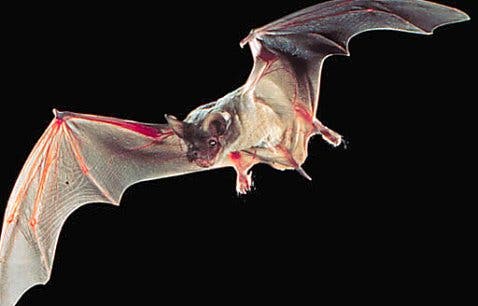Apart from echolocation, bats have another ace up their sleeve that makes them formidable flying animals: tiny hairs that sense airflow and transmit this information to key areas of the brain. Here the info is decoded and used to steer the bats’ flight for pinpoint accuracy. In combination with echolocation, this makes bats awesome hunters even in pitch black darkness.

Neuroscientist Cynthia F. Moss of Johns Hopkins University and her colleagues first applied a depilatory cream to bat wings. The cream was applied briefly, then cleaned off, but it was enough to remove the microscopic hairs that cover the membrane on the bat’s wings. Experiments showed that the bats could still fly in a dark room, thanks to their echolocation, but not nearly as accurate. Their turns were much wider and the subtle precision of their mid-air dives was clearly affected.
Next, Moss strapped brain activity measurement devices to the heads of shorn and non-shorn North America’s big brown bats. The researchers applied puffs of air to their wings, while registering activity in the somatosensory cortex, where things like touch and pain are handled. The bats with missing hair showed no response, while non-shorn bats lit up in the respective region. In addition, the researchers discovered a large number of sensory cells called Merkel cells, which were shown to be associated with these micro hairs. Moss believes these cells transmit information about hair movement, but also during dexterous displays of flight like when clenching a prey or hitting the break mid-air.
The discovery of their hairs also raises a lot of important evolutionary questions. Bats are the only mammals capable of genuine self-powered flight. Other mammals, like so-called flying squirrels, can only glide. But it’s very likely that bat ancestors started out this way as well, gliding from tree to tree until it membranes developed flight capabilities. Over the years, the ability to execute fine maneuvers necessary to catch their favorite prey (insects) likely caused the bats to develop these highly valuable sensory hairs. When this happened is difficult to assess, however. Findings were published in Cell Reports.
“These findings can inform more broadly how organisms use touch to guide movement,” Moss said.
Just last week, ZME Science reported the discovery of a new peculiar dinosaur species called Yi Qi. The dinosaur had bat-like wings, but was covered both in feathers and hair. Whether it could fly or not is very disputed, but it definitely glided, as evidenced by it’s huge membrane that covered its upper limbs. Perhaps, Yi Qi might answer many evolutionary riddles currently surrounding bat flight.






